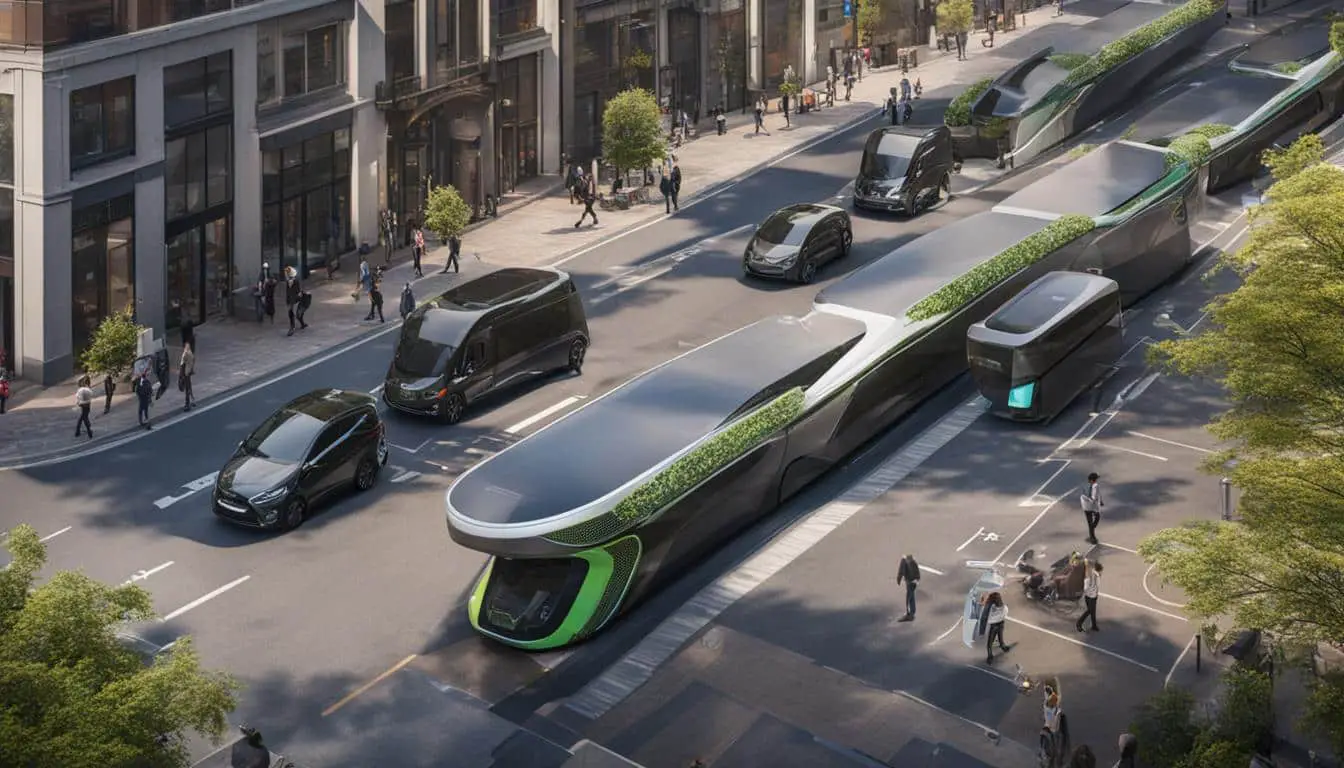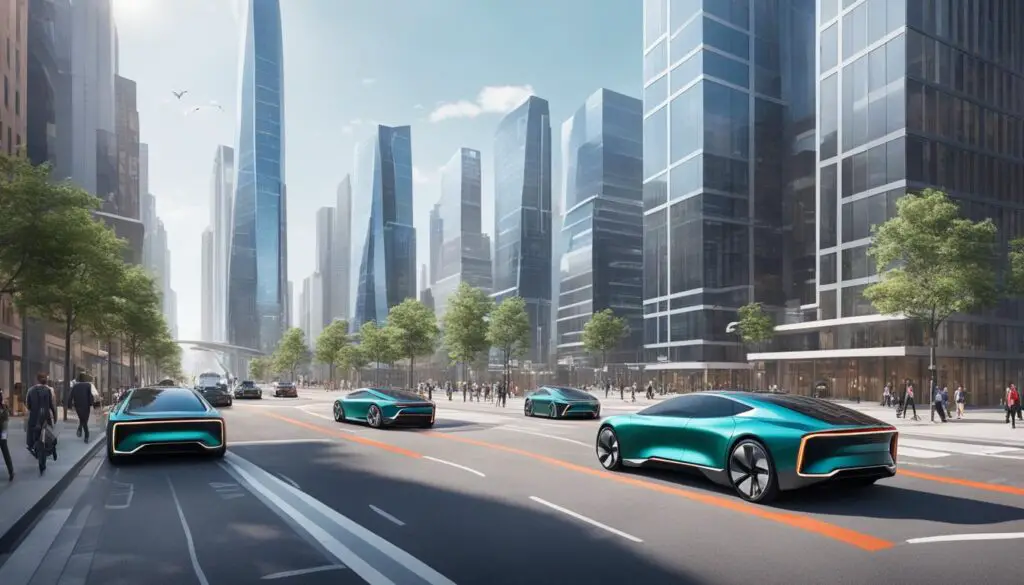
The Future of Urban Road Design for Autonomous Vehicles
As the development of autonomous vehicles progresses, the future of urban road design is being reimagined to accommodate the unique needs of self-driving cars. With automakers such as Ford planning to launch commercial autonomous vehicle fleets by 2021, the engineering and construction industry is preparing for a significant shift in infrastructure and transportation.
Designing urban roads for autonomous vehicles involves various considerations, including changes in infrastructure, funding, efficiency, and safety. The transition to self-driving cars will have far-reaching implications, necessitating a redesign of roadways to optimize their capabilities and ensure seamless integration into our cities and towns.
Key Takeaways:
- Autonomous vehicles are expected to have a disruptive impact on roadway infrastructure and transportation systems.
- Funding for road improvements may shift from motor fuel taxes to a toll-type basis, allowing for increased investment in enhancing roadway efficiency.
- The precise driving patterns of autonomous vehicles may require a redesign of road surfaces, incorporating reinforced-concrete grade beams and permeable materials.
- The transition to autonomous vehicles could lead to narrower roadways, optimal pedestrian crossings, and a decrease in parking spaces.
- The future of urban road design holds significant implications for the engineering and construction industry, necessitating proactive planning and collaboration.
Implications for Roadway Infrastructure
The transition to autonomous vehicles will have significant implications for roadway infrastructure. In this section, we will explore the funding shifts, enhanced efficiency, and disruptive impacts that autonomous vehicles will bring to our roads.
Funding Shifts
One of the notable changes in roadway infrastructure that will accompany the rise of autonomous vehicles is the shift in funding. Currently, highway and street infrastructure is primarily funded through motor fuel taxes. However, as autonomous vehicles become more prevalent, funding will transition towards a toll-type basis.
This shift in funding will have several benefits. First, it will allow for increased funding for road improvements, including maintenance, repairs, and upgrades. Second, it will provide a more sustainable and predictable revenue stream for infrastructure development. Overall, this shift in funding will ensure that our roads are adequately prepared to accommodate autonomous vehicles and their unique needs.
Enhanced Efficiency
Autonomous vehicles promise to bring enhanced efficiency to our roadways. With their advanced technologies and precise driving capabilities, autonomous vehicles will lead to a reduction in lane width and an increase in roadway capacity.
This increased efficiency will have several benefits. It will result in a decrease in the volume of additional highway infrastructure required, such as widening and new alignment. Moreover, the accurate and predictable movements of autonomous vehicles will optimize the use of existing road space, reducing congestion and improving traffic flow.
Disruptive Impacts
The advent of autonomous vehicles will have disruptive impacts on transportation systems, particularly in second-tier metropolitan markets. Public rail transit systems may face potential obsolescence as autonomous vehicles offer alternative modes of transportation.
This disruption will require careful planning and evaluation of the future of transportation infrastructure. Municipalities and transportation authorities will need to consider how autonomous vehicles can complement or replace existing public transit systems, ensuring efficient and sustainable mobility for all individuals.
Redesigning Roadways for Autonomous Vehicles
The precise driving patterns of autonomous vehicles can cause repetitive wear damage to road surfaces. To accommodate autonomous vehicles, roadways may need to be redesigned with reinforced-concrete grade beams for vehicles to drive along. The road surface between and around these beams could be made permeable, allowing for stormwater retention and recharge of aquifers. This redesign would require narrower lanes and fewer signs, resulting in a reduced footprint for roadways. Additionally, the future of road design for autonomous vehicles may involve the removal of parking lots and the integration of more green space.
Autonomous vehicles’ precise driving patterns can result in repetitive wear damage to road surfaces. Redesigning roadways with reinforced-concrete grade beams for vehicles to travel along could mitigate this issue. These grade beams would offer additional support and durability, extending the lifespan of road surfaces. Additionally, permeable road surfaces between and around the grade beams would provide environmental benefits. They would allow for stormwater retention, reducing the strain on drainage systems, and recharge aquifers, promoting sustainable water management.
The integration of permeable road surfaces could also help mitigate urban heat island effects by allowing rainwater to infiltrate into the ground, reducing surface temperature. Furthermore, narrower lanes and fewer signs would not only accommodate autonomous vehicles but also reduce the overall footprint of roadways. This could lead to the removal of parking lots, freeing up valuable land in urban areas.
By repurposing parking lots and integrating more green space, cities can transform underutilized areas into vibrant public spaces that promote community engagement and provide environmental benefits. These green spaces could help mitigate urban heat island effects, reduce air pollution, and enhance the overall quality of life for urban residents.

| Benefits | Description |
|---|---|
| 1. Enhanced Durability | Reinforced-concrete grade beams provide additional support, reducing wear damage to road surfaces. |
| 2. Environmental Sustainability | Permeable road surfaces allow for stormwater retention and recharge of aquifers, promoting sustainable water management. |
| 3. Efficient Land Use | Narrower lanes and reduced signage result in a reduced footprint, potentially allowing for the removal of parking lots and the integration of more green space. |
By redesigning roadways for autonomous vehicles, cities can create a more sustainable and accommodating transportation infrastructure. This not only prepares for the future of autonomous vehicles but also promotes environmental stewardship and enhances the overall livability of urban areas.
Changes in Roadway Design and Land Use
The anticipated capabilities of driverless cars will have significant implications for roadway design and land use. As autonomous vehicles become more prevalent, we can expect to see changes that optimize traffic flow and create a more efficient urban environment. Let’s explore some of the key changes and their implications.
Narrower Roadways
With the introduction of autonomous vehicles, roadways will likely become narrower. The precision and advanced technology of driverless cars will enable them to safely navigate through narrower lanes. This will result in a reduction of lane width and fewer lanes overall. The narrower roadways will not only accommodate the narrower dimensions of autonomous vehicles but also create more space for other uses.
Optimal Pedestrian Crossings
One of the advantages of autonomous vehicles is their ability to communicate and coordinate with each other. This capability opens up opportunities to optimize pedestrian crossings. With autonomous vehicles on the road, signalization at pedestrian crossings may become unnecessary. Instead, pedestrian crossings can be placed at optimal locations based on traffic patterns, ensuring efficient flow for both vehicles and pedestrians.
Implications for Land Use
The transition to driverless cars could lead to a decrease in the need for parking spaces. With fleets of autonomous vehicles operating like a modern transit system, individually owned vehicles may become less common. This shift will free up land that is currently dedicated to parking spaces, allowing for alternative uses. As a result, we may see more mixed-use developments with a focus on walkability and green spaces.
In addition to freeing up land, the removal of overhead streetlights may reduce light pollution in cities and suburbs. With autonomous vehicles equipped with advanced sensors and navigation systems, the reliance on traditional street lighting may diminish, leading to a more environmentally friendly and visually appealing urban landscape.
Overall, the changes in roadway design and land use brought about by autonomous vehicles will have a profound impact on our cities. Narrower roadways, optimal pedestrian crossings, and the repurposing of parking spaces will create more efficient and sustainable urban environments. As we embrace the future of transportation, it is crucial for city planners and policymakers to consider these implications and adapt our infrastructure to meet the evolving needs of autonomous vehicles.

Conclusion
The future of urban road design for autonomous vehicles has profound implications for the engineering and construction industry. As we transition to a world with self-driving cars, our infrastructure, funding models, and roadway design must be adapted to meet the unique needs of these vehicles. Redesigned roadways will not only be more efficient and environmentally friendly but also better suited to accommodate autonomous vehicles’ requirements.
One significant impact of this shift will be the potential repurposing of parking lots. With the rise of autonomous vehicle fleets, traditional parking spaces could become unnecessary. This opens up exciting opportunities for more green spaces and mixed-use developments, ultimately transforming the urban landscape. The integration of green space not only enhances the aesthetic appeal of cities but also contributes to environmental sustainability.
It is crucial for municipalities and industry professionals to stay informed and proactive in planning for the future of urban road design. As autonomous vehicles continue to develop, collaboration between engineers, construction professionals, and local authorities will be essential to ensure smooth integration and maximize the potential benefits. Together, we can create roadways that are safe, efficient, and conducive to the advancements in autonomous technology, shaping the cities of tomorrow.
FAQ
How will the transition to autonomous vehicles impact urban road design?
The transition to autonomous vehicles will require a redesign of urban roads to accommodate their unique needs, including changes in infrastructure, funding, efficiency, and safety.
What funding changes can we expect for roadway infrastructure?
Funding for highway and street infrastructure will shift from motor fuel taxes to a toll-type basis, allowing for increased funding for road improvements.
How will autonomous vehicles affect roadway capacity?
The enhanced efficiency and accuracy of autonomous vehicles will lead to a reduction in lane width and an increase in roadway capacity, resulting in a decrease in the volume of additional highway infrastructure required.
What impact will autonomous vehicles have on transportation systems?
Autonomous vehicles may disrupt transportation systems, potentially leading to the obsolescence of public rail transit systems in second-tier metropolitan markets.
How will autonomous vehicles impact road surfaces?
The precise driving patterns of autonomous vehicles can cause repetitive wear damage to road surfaces, which may require redesigning roadways with reinforced-concrete grade beams for vehicles to drive along.
Will roadways for autonomous vehicles be more environmentally friendly?
Yes, roadways for autonomous vehicles may be redesigned with permeable surfaces, allowing for stormwater retention and recharge of aquifers. This would result in a reduced footprint for roadways and the integration of more green space.
Will narrower roadways be necessary for autonomous vehicles?
Yes, the anticipated capabilities of autonomous vehicles will result in narrower roadways with narrower lanes and fewer lanes overall, allowing for optimal placement of pedestrian crossings without the need for signalization.
How will the transition to autonomous vehicles affect land use?
The transition to autonomous vehicles could lead to a decrease in parking spaces as fleets of self-driving cars operate like a modern transit system. This would free up land for alternative uses, potentially resulting in more mixed-use, walkable development.
Will the transition to autonomous vehicles reduce light pollution?
Yes, the removal of overhead streetlights, which may no longer be necessary, could reduce light pollution in cities and suburbs.
How should municipalities and industry professionals prepare for the future of urban road design?
It is vital for municipalities and industry professionals to stay informed, be proactive, and plan for the future of urban road design as the development of autonomous vehicles continues.
Source Links
- https://fmicorp.com/insights/quarterly-articles/how-autonomous-vehicles-will-change-the-future-of-road-design-and-construction
- https://www.asce.org/publications-and-news/civil-engineering-source/civil-engineering-magazine/article/2021/08/how-autonomous-vehicles-will-change-road-designs
- https://www.sehinc.com/news/future-what-do-driverless-cars-mean-road-design
